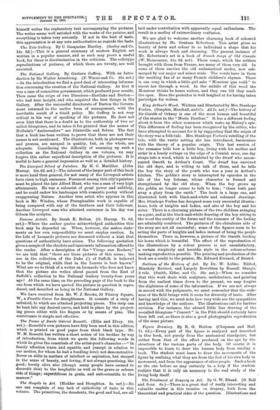King Arthur's Wood. Written and Illustrated by Mrs. Stanhope Forbes.
(Simpkin, Marshall, and Co. £2 2s. net.)—The history of Sir Gareth of Orkney is one of the most human and beautiful of the stories in the "Norte Darthur." It has a different feeling about it from the other romances which make up Malory's epic. This difference of feeling has been recognised by the critics, who have attempted to account for it by suggesting that the origin of the story was a folk-tale. Mrs. Stanhope Forbes's retelling of the tale, with the rustic setting she has introduced, harmonises with the theory of a popular origin. This last version of the romance tells how a little boy, living with his mother and sister in a lonely cottage on the edge of a Cornish moor, one day strays into a wood, which is inhabited by the dwarf who accom- panied Gareth to Arthur's Court. The dwarf has survived the old days, and is willing to talk of them, and he tells the boy the story of the youth who was a year in Arthur's kitchen. The goblin's story is interrupted by episodes in the life of the boy listener, whose character is formed and strengthened by the old story. When the boy grows up the goblin no longer comes to talk to him; "there hath past away a glory from the earth." The book is a large one, and illustrated both with black-and-white and coloured drawings. Mrs. Stanhope Forbes has designed some very successful illustra- tions, both of knights and lathes, and also of the boy and his sister. There is a charming picture of the two children swinging on a gate, and in the black-and-white drawing of the boy sitting in the wood the reality of the forms and the romance of the feeling are admirably combined. The pictures of the chivalrous side of the story are not all successful ; some of the figures seem to be acting the parts of knights and ladies instead of being the people themselves. There is, however, a picture of Sir Gareth leading his horse which is beautiful. The effect of the reproduction of the illustrations by a colour process is not unsatisfactory, a certain simplicity and heraldic style in the colour-scheme making reproduction possible. The printing and production of the book are a credit to the printer, Mr. Edward Everard, of Bristol.






















































 Previous page
Previous page